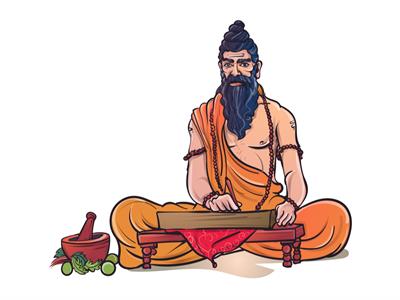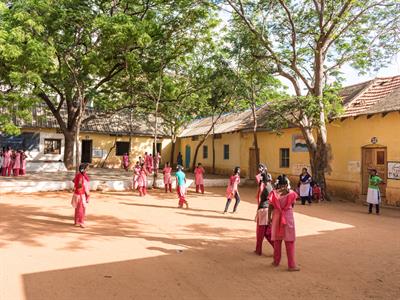PDF chapter test TRY NOW
Part I
Santosh Yadav was born on \(10\) October \(1967\) in the small village called Joniyawas, which belonged to the Rewari district in Haryana. She is the first woman in the world to have climbed Mount Everest twice. Although she had achieved such great things in life, she had her own fair share of struggles growing up and following her passion. In general, the society lays out separate rules for women in terms of education or career. Many people, especially in Indian villages, consider it unwelcoming and a burden when a girl is born into the family. A birth of a son is considered auspicious, and people welcome him with much joy. Santosh's birth had a different take, even though she was from a village. When her mother was carrying her in the womb, she was visited by a holy man. In the early days, holy men who had sacrificed all materialistic joys of the world, sought God by visiting temples and holy places. They were believed to have special powers and people respected them. The holy man who visited Santosh's mother assumed that they wanted a son, as he must have experienced a lot of families asking him to bless them for a son.

Holy man
Santosh's grandmother surprised everyone when she assertively stated that she wanted the holy man to bless the mother to have a daughter. This shows that her grandmother was very progressive and did not go by the standard beliefs of the village. As destiny would have it, Santosh was born in the family just as if the holy man's blessing had come true. When people truly wish for something to happen and believe in it, it manifests in the form of a miracle or destiny. She was born as the sixth child in a family that had five sons.

Girl in shorts
Santosh was not born in a very underprivileged family who could not afford their children's education. In Haryana, most villages had landowners who based their life on farming, selling the products etc. and were affluent. Children from the villages usually go to the cities to pursue education, as they usually meet the standards providing a different exposure. But Santosh's parents did not send her to the city even if they could afford her education in New Delhi, which is the nearest city and is only 3 hours away. This could be owing to the fact that they did not feel it was safe for a girl to stay in a residential school outside her home.
Santosh, therefore, went to a local village school near her home in the initial stages of her life. But she was not any normal girl who would settle for what was only offered to her. Although she had to accept her parent's choice, she quietly waited for the right moment to change the situation. She realised that complaining about something not happening in life and accepting it as fate will not take a person to any greater heights. Instead, one must grab the right opportunity at the right time. She waited for an opportunity to act and convince her parents. This moment came when she turned sixteen. This was the age when most girls in the village were married off. Santosh knew that it meant a great deal to her parents. Although she was least interested in getting married, she threatened that she would never marry if she was not sent to the city to receive the proper kind of education.

A school in village*
Santosh knew very well to transform a stressful situation into an opportunity. Any person, given the situation, would focus on convincing the parents to not get them married off. But that would only strengthen the parent's decision regarding the marriage. Santosh giving them an option to either send her to the city or forget about getting her married, made the parents think. She did not want to get married at a young age without receiving proper education, as this would make her dependant on her husband for all financial and emotional needs. She understood that education is really important for young girls to be happy and independent. When her parents refused to pay for her studies in the city, she made up a bold decision to work part-time to pay school fees. This determination made her parents recede and agree to pay.
Santosh did not stop after completing her school education, unlike most other girls from the village. She always wanted a bit more when it came to her studies. She enrolled herself in Maharani College, Jaipur. Her father had by now gotten used to her desires and the fact that no matter what they said, she would chase her dreams. The girl who had to nearly threaten her parents to study in Delhi now travelled and stayed in Jaipur, which was the capital of Rajasthan. She stayed in a hostel called Kasturba Hostel near her college. Her room in the hostel happened to be facing the Aravalli range, which was a mountain range that started in Delhi and passed through Haryana and Rajasthan.

Aravalli range
She saw the villagers going up the mountain and climbing down the other end of the range. It looked like they were disappearing to her. She decided to check what was the reality as she was curious and went to the range all by herself. When she had gone there, she could only see a group of mountaineers, who generally ascend tall ranges and mountains. It is considered one of the most refreshing outdoor activities. It was a turning point in Santosh's life as it was the first time she explored mountaineering with them. They even motivated her to climb along with them.

Mountaineers
Since this opened a new window to her, Santosh, who always wanted to go an extra mile when it came to exploring, decided to take it up as a course. She saved money when she was in college and enrolled in the Nehru Institute of Mountaineering in Uttarkashi, Uttarakhand. There are 4 recognised mountaineering colleges in India that teach all about outdoor safety, wilderness navigation, rock craft, safety measures etc. Mountaineering is an ideal course for people who want to explore and find themselves in nature. She was supposed to join the course on May twenty-first. But her college course, which was supposed to end in April, got extended to May nineteenth, which did not give her any time to plan for the mountaineering course. But she did not give up, citing not informing her parents as a reason. Instead, she wrote a letter to her father seeking an apology and went straight ahead to join the course in Uttarkashi.

Uttarkashi
Santosh had a vision when she enrolled on the course for mountaineering. She even earned the wrath of many people for doing so without proper intimation. But Santosh knew that if she listened to what everyone has to say, then she would not be able to live life to the fullest. She enrolled in the course and proved everyone wrong as she soon became an expert in it. She went on an expedition where she scaled various mountains every year. She knew that she had to develop skills in any particular area to excel in it. She constantly pursued it, in spite of hardships, and became a pro in climbing mountains. She knew all the risk factors and the ways to tackle them too.
When one keeps doing something continuously and passionately, they tend to develop resistance and it becomes more of a habit. Likewise, Santosh developed resistance to the cold weather and the heights of the mountains. The weather on top of a mountain is usually very cold and most of them are covered with snow. The higher the place is above sea level, the more chillness in the air tends to increase. Sometimes, it causes dangerous catastrophes like a blizzard. One needs to exert great determination to scale a mountain. But Santosh proved her talent by equipping herself with all the skills needed, an iron will, and toughness. One has to be physically and mentally fit in order to scale mountains, which she maintained constantly. All hard work yields results, and so did Santosh's hard work and sacrifices. She became the first woman to scale Mount Everest, the highest mountain above sea level, in \(1992\), when she was barely \(20\) years old. The shy, nervous girl who had asked a group of mountaineers if she could join them to climb Aravalli Ranges four years ago had become the youngest mountaineer to scale Mount Everest.

Mount Everest
The growth and development of a person do not mean anything if they are not humble enough. But Santosh was known for the humility that she exhibited even after reaching greater heights. She still looked up to her seniors and worked without any ego with her juniors. The most significant role in her mountaineering life was when she had to save the lives of two fellow mountaineers who fainted due to a lack of oxygen supply. In her first attempt to scale Mount Everest in 1992, she tried to rescue a climber lying dying at the South range. Though she was unsuccessful in rescuing him, she succeeded in saving another climber, Mohan Singh, who would have met with the same fate had she not shared her oxygen with him.

Oxygen in mountain
When most people bask in the joy of success, they tend to lose sight of the future. Consistency is the key to eternal success. One big achievement blinding the eyes of great personalities has led to their downfall. They do not put any effort after getting fame and later on regret it. But Santosh was not one among them. She continued to go on expeditions with all groups of mountaineers. Within a year of becoming the first Indian woman to climb Mount Everest, she set out to scale it for the second time.
She became a member of the Indo-Nepalese Women’s Expedition, which was the first all-women expedition, started in \(1993\), launched by the Indian Mountaineering Foundation, funded by the Ministry of Youth Affairs and Sports. She set out to scale Mount Everest for the second time with the team and succeeded, and hence set a record as the only woman to have scaled the Everest twice. Her achievement elevated India's status in the realm of mountaineering, as it is always a pride to be a country to have a woman who has scaled the highest peak twice. As she gained a huge name and respect for the country with her achievements, she was honoured with the most prestigious award, 'Padmashri'. It is the fourth highest civilian award in India, given to people who have made contributions in various fields.

Women mountaineers
When she was asked about how she felt to be at the top of the world, she answered that when something as huge as this happens, it takes a moment to understand and let the situation sink in. During moment's of success, one might not be able to believe it and it can take a few moments before happiness sets in. Similarly, Santosh was proud and happy as she unfurled the Indian flag at the top of the mountain. People who make achievements display their country's flag on top of the mountain. This is similar to astronauts placing flags when they land on the moon or any other planet. It is considered as bringing pride to one's own country, and the feeling is indescribable. Being an ardent environmentalist, she collected almost 500 kilograms of garbage that was thrown across the Himalayas. People visit places that are so close to nature and ruin it by throwing garbage, which leads to various natural calamities. Santosh was a responsible mountaineer as well as a citizen.

Garbage on mountain areas
Part II
Maria Yuryevna Sharapova is a Russian former No.1 tennis player born \(9\) April \(1987\), in Siberia. She played under the banner of Russia but was a permanent resident of the US. The lesson discusses as to how Sharapova reached great heights in such a short span of time. She was beautiful, talented in her field, and carried a disarming vibe to herself. She gained the world No.1 title for the first time on Monday, \(22\) August \(2005\), when she was barely \(18\) years old. She won five grand slam titles, which is considered to be the highest achievement in the field of tennis. All this happened in just four years of her entering the game. She first entered the scene of tennis when she was just \(13\) years old and won the Eddie Herr International Junior Tennis Championships. By sheer talent and determination, she marched forward to gain the most prestigious No. 1 title in tennis.

Maria Sharapova**
Sharapova's success did not come easily as it seemed. She had her own fair share of struggles and rough patches, which she had to experience from a very young age. She was taken by her father, Yuri Sharapov, who had already introduced her to the game of tennis at a very young age as a child. She was recommended to do professional training with Nick Bollettieri at the IMG Academy in Bradenton, Florida. In order to pursue it as a serious profession/passion, they took debts from various people and moved to the US. But unfortunately, her mother, Yelena, had to stay back in Russia due to visa restrictions, making them separate for two years. This deeply affected a very young Maria. But her father took up odd jobs until she was provided with a scholarship and taken in by the academy at the age of nine. Until then, she barely even saw him as he was taking up all kinds of jobs to help them sustain themselves in a new country. She used to be lonely and missed her parents terrible. But she channelled the anger on tennis. Her tennis excellence came at a huge price of sacrifice and contribution made by her parents.
Maria Sharapova, when recalling her earlier days in the academy, stated that she had faced discrimination from her fellow tennis pupils, who were mostly her seniors. Sometimes young girls get very insecure when they see someone younger than them, for someone from a different country, perform better than them. They project that insecurity in different ways by harassing or bullying them. Most young immigrant kids are subjected to bullying in the US. Similarly, Maria being a young child, was allowed to sleep by 8 pm so that it was feasible for her to wake up in the morning and practise. But the senior team pupils would wake her up at 11 pm and order her to tidy up the room. But in spite of all this, Sharapova managed to get trained in the game she was passionate about.

Bullying
Sharapova took inspiration from the hardships that she faced. Although it is important to react to certain thing, some things have to be ignored, and our success must speak for itself. She used this philosophy in life and was silent when the bullying happened. She kept improving her skills and worked hard to prove herself. She became quietly determined and mentally tough. She knew very well what she wanted from life. She was clear about her dreams and never even thought to quit on them. The petty issues that she was facing were not worth quitting on her passion. Since she came from a very humble background, she was hungry for success as this was her only way out. She would have put up with all the insults in the world to reach her dream, as the insults are temporary, but passion is permanent. This attitude is what led her to bag the women’s singles crown at Wimbledon in \(2004\) and put her on the World's top player list.

Wimbledon tennis court***
Her story of hailing from a humble background in Siberia to becoming the number 1 player in tennis has proved to be an inspiration to many youngsters. She serves as a role model to a lot of young girls who want to achieve their dreams but are facing struggles. But contrary to the popular norm of celebrities gaining sympathy with their sad stories in the media, Sharapova comes out as a very straightforward and practical person. She focuses on the game, works hard to win and considers that her sacrifices were worth it. Her mantra for success is, “I am very, very competitive. I work hard at what I do. It’s my job.”
Sharapova had moved to America when she was as young as \(7\). When she set out to the US, with her father, with only her dreams to keep her company, she did not know to speak English. But the determined person that she is, not only did she grasp the language, but she also learnt to speak it fluently with a proper American accent. But she goes by the belief that no matter where one is, one must not forget the roots. She does not shy away from owning to her Nationality. She proudly claims herself to be Russian and parades her Nationality in all forms of media. Many people raised doubts about her roots and where she hailed from, as she had settled in the US at a very young age, even before rising to great fame and success.

Sharapova played for Russia****
Sharapova put an end to all speculations as she herself proudly stated that although she is settled in America, and the country had played a vital role in all her success, she still identifies herself as a Russian. She states that her blood is Russian, as one cannot change one's past or foundation. The Olympics is the best forum for any sporting personality to gain fame for their country. Sharapova also wanted to represent Russia as her home country in the Olympics, which she did in \(2012\), as she bagged a silver medal.
People have a misconception that women in sports are particularly tough and are not into fashion or entertainment. But women can choose whoever they want to be and like whatever they want to. Their profession does not determine their likes or interests. Similarly, Sharapova is very much into fashion, singing, dancing apart from sports. She also reads books as she claims Arthur Conan Doyle, who is famous for his Sherlock Holmes books, as her favourite author. She loves to wear gowns and eat chocolate pancakes with orange fizzy drinks, clearly showing that she is pretty much like any other normal person, irrespective of her celebrity status. When asked about the money aspect in the game, She was practical enough to say that money did work as a motivation, but what matters in the end was the fact that one is the best in the game. The dream of becoming the number one player is what motivated her to follow her dreams.

Sherlock Holmes by Arthur Conan Doyle*****
Reference:
- A school in village*: gg-foto / Shutterstock.com
- Maria Sharapova**: Jimmie48 Photography / Shutterstock.com
- Wimbledon tennis court***: Meaning March / Shutterstock.com
- Sharapova played for Russia****: Mirt Alexander / Shutterstock.com
- Sherlock Holmes by Arthur Conan Doyle*****: Plateresca / Shutterstock.com
